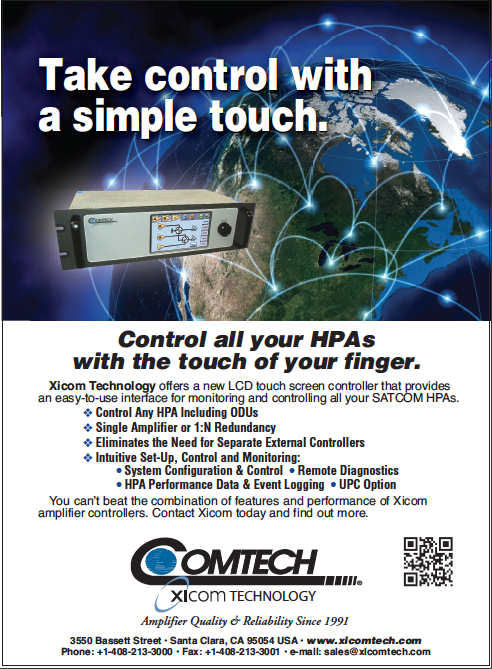The rise of “Bring Your Own Device” (BYOD) over the past few years has significantly transformed the world of mobile telecommunications. Whether it is a business executive accessing the office networks while on the move, or an offshore crew member using a smartphone and tablet to communicate, today’s connected consumers demand the flexibility of using their personal devices.

Increasingly, these trends are no longer unique to the mobile, terrestrial sector—today they wish for access to more data applications with seamless transition between networks, and that includes satellite. At the same time, the success of companies such as Apple and Samsung has led to heightened consumer expectations for the satellite industry to innovate and create new, game-changing products.
Consider the growing consumer influence on how satellite products and services are being designed, developed and delivered. Consumer perceptions of satellite equipment have evolved radically to the point where hefty satellite handsets no longer fit the bill. End-users now expect satellite phones to come in a sleek form factor, with enhanced functions and data capabilities that allow them to access social media and popular apps with ease.
While staying ahead of the latest mobility trends can be a challenge, the opportunities for the satellite industry to embrace the new realities of BYOD are simply too compelling to ignore. The following consumer-oriented developments serve as strategic guideposts for satellite operators to rethink and transform their business:
Delivering solutions that address consumer demands across networks
We are seeing the emergence of new products and exciting application development that are bringing the industry another step closer to the seamless integration between terrestrial and satellite communications.
From the satellite perspective, this means taking a closer look at how consumer behavior is impacting the way mobile devices are being used—and being able to deliver the products and network coverage to keep pace with evolving consumer demands. Satellite operators also need to take into consideration whether the products they develop can support popular consumer handset platforms, such as the iPhone or Samsung Galaxy.
The introduction of new, consumer-oriented form factors such as the Thuraya SatSleeve—which provide access to satellite connectivity with greater ease and convenience—clearly reflects this trend. Satellite end-users no longer have to carry a dedicated satellite handset everywhere, and they are now able to access data applications via their personal device of their choice, even when operating outside of GSM coverage.
The convergence between the satellite and terrestrial mobile sectors is fast becoming the norm, and is already considered to be business-as-usual for Thuraya. With more than 360 roaming agreements with mobile network operators around the world, end-users are able to use Thuraya devices just as effectively over the Thuraya satellite network or on
GSM networks.
Broadening distribution beyond traditional satellite sales channels
As the lines between terrestrial and satellite continue to blur, another strategic differentiator for satellite operators can be achieved through deepened collaboration with service partners in the mobile terrestrial space.
In order to succeed in the consumer sector, there is added impetus for satellite operators to adopt a business model and product development cycles that are on par with mobile operators. We foresee a growing trend for satellite devices to be sold through mobile operators or be commercially available directly at retail stores alongside consumer phones—in a slick form factor and user interface that are virtually identical to that of a consumer mobile handset.

Establishing an ecosystem dedicated to fostering innovative platforms
The increased consumer orientation also means that the satellite industry, as a whole, needs to develop new, competitive products, and get them to market faster.
Traditionally, satellite operators do not consider the applications that ride on top of their networks as being part of their core business focus. However, this way of thinking is rapidly being challenged. To meet the requirements of the consumer market, satellite operators are starting to place more focus on supporting partner ecosystems to foster new innovation streams.
As part of our efforts to establish an entire ecosystem that will respond quickly to market trends, Thuraya is delivering new tools and network capabilities that enable developers to accelerate the pace of product development.
An example is the recently launched Thuraya VIPturbo Module, which serves as the engine for developing new broadband terminals that ride on the Thuraya network. We believe the Thuraya VIPturbo Module holds great potential for empowering partners to develop innovative products that address the latest BYOD demands.
By focusing on addressing emerging consumer demands and the latest technology shifts, Thuraya is building the next generation of agile, market-focused satellite solutions.
This is not your father's satellite company.

For further information regarding Thuraya, please visit http://www.thuraya.com/
About the author
Randy Roberts is responsible for driving product and solution innovation strategy. Based in Dubai, Randy leads the product development, product management and solutions engineering teams. He is also responsible for managing the business intelligence team to drive continuous development and enhancement of Thuraya’s product lifecycle management process.


